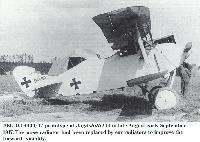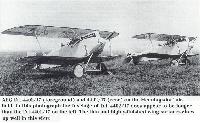
Описание
Страна: Германия
Год: 1917
Истребитель
O.Thetford, P.Gray German Aircraft of the First World War (Putnam)
A.E.G. D I
Entry of A.E.G. into the single-seat fighter field was marked in May 1917 by the appearance of the stocky D I. Two further prototypes, D 4401/17 and D 5002/17, were fitted with "ear"-type radiators and differed little except that D 5002/17 (below) had slightly longer radiator strips. Engine, 160 h.p. Mercedes D III. Span, 8.5 m. (27 ft. 10 3/4 in.). Length, 6-1 m. (20ft. 0 1/4 in.). Height, 2.65 m. (8 ft. 8 3/8 in.). Weights: Empty, 685 kg. (1,507 lb.). Loaded, 940 kg. (2,068 lb.). Speed, 220 km.hr. (137.5 m.p.h.). Climb, 1,000 m. (3,280 ft.) in 2.5 min., 5,000 m. (16,400 ft.) in 25 min.
A.E.G. Dr I
Introduced in October 1917, this triplane version of the D I offered no increase in climb performance, and the speed showed a reduction. It was developed no further. Engine, 160 h.p. Mercedes D III. Span, 9.4 m. (30 ft. 10 1/8 in.). Length, 61 m. (20 ft. 0 3/4 in.). Weights: Empty, 710 kg. (1,562 lb.). Loaded, 970 kg. (2,134 lb.). Speed, 170 km.hr. (106.25 m.p.h.).
Описание:
- O.Thetford, P.Gray German Aircraft of the First World War (Putnam)
- W.Green, G.Swanborough The Complete Book of Fighters
- J.Herris AEG Aircraft of WWI (A Centennial Perspective on Great War Airplanes 16)
- M.Dusing German Aviation Industry in WWI. Volume 1 (A Centennial Perspective on Great War Airplanes 84)
- Сайт Pilots-and-planes
Фотографии
-
J.Herris - AEG Aircraft of WWI /Centennial Perspective/ (16)
AEG D.I 4400/17
-
W.Green, G.Swanborough - The Complete Book of Fighters
The first A.E.G. DI which appeared in May 1917.
-
O.Thetford, P.Gray - German Aircraft of the First World War /Putnam/
The AEG D.I prototype, 4400/17, photographed at the Nieder-Neuendorf airfield in May 1917. Because the narrow airfoil section did not allow the installation of an airfoil radiator, a nose radiator was installed. The long exhaust stack reduced exhaust noise.
The AEG D.I owed nothing to the Nieuport and was a very fast, promising design. Powered by the same 160 hp Mercedes engine used in the Albatros fighters and mounting two machine guns, it climbed as well as the Albatros and reached 225 km/h (137 mph), making it the fastest fighter of its day. Three prototypes were built but after two unexplained fatal crashes, development was cancelled. Like all AEG designs its structure was welded steel tube. -
Сайт - Pilots-and-planes /WWW/
AEG D.I 4400/17 prototype at Jagdstaffel 14 in late August - early September 1917. The nose radiator had been replaced by ear radiators to improve the forward visibility.
-
J.Herris - AEG Aircraft of WWI /Centennial Perspective/ (16)
AEG D.I 4400/17 now has side radiators. It is shown here on Marville airfield shortly before Lt. Hohndorf's fatal flight in it on Sept. 5, 1917 that essentially ended D.i development despite its high speed.
-
J.Herris - AEG Aircraft of WWI /Centennial Perspective/ (16)
AEG D.I 4400/17 now has side radiators and a shorter exhaust stack. It is shown here on Marville airfield shortly before Lt. Hohndorf's fatal flight in it on Sept. 5, 1917 that essentially ended D.I development despite its high speed.
-
H.Cowin - Aviation Pioneers /Osprey/
With only a handful built, the AEG D I was one of the rarer types to find its way into front-line service with the single seater units during the latter half of 1917. Armed with twin 7.92 Spandaus and powered by a 160hp Mercedes, this diminutive fighter had a useful top level speed of 124mph, but this could well have been counter-balanced by poor climb, tricky handling and longish take-off requirement, if the machine's wing loading was as high as the photograph would suggest. The AEG D I, 4400/17, shown here belonged to Lt Walter Hohndorf, leader of Jasta 14. It was in this fighter that Hohndorf crashed to his death on 5 September 1917, after a combat in which he had scored his 12th 'kill'.
-
J.Herris - AEG Aircraft of WWI /Centennial Perspective/ (16)
AEG D.I 4401/17 has a longer fuselage than the prototype for better stability. Ear radiators are fitted and the exhaust stack is much shorter than the prototype. The German fighter pilots needed an aircraft with the speed of the AEG D.I, which was faster than any operational German fighter of the war, so the decision to cancel it despite two fatal accidents must have been difficult. In retrospect it seems that continued development was warranted due to the aircraft's potential unless there was a fundamental and irreparable flaw in the design, which does not appear to be the case. The cause of the accidents was never determined so the potential for making the aircraft safer through further development is unknown. However, the small number of production aircraft were flown for some time, including as comparison aircraft in the First Fighter Competition, without further fatalities, bringing its cancellation into question.
-
M.Dusing - German Aviation Industry in WWI. Volume 1 /Centennial Perspective/ (84)
The AEG D.I reached 210 km/h in level flight.
-
Сайт - Pilots-and-planes /WWW/
AEG D.I 4401/17 (foreground) and 4402/17 (rear) on the Henningsdorf airfield. In this photograph the fuselage of D.I 4402/17 does appear to be longer than the D.I 4401/17 on the left. The thin and highly-finished wing surfaces show up well in this view.
-
O.Thetford, P.Gray - German Aircraft of the First World War /Putnam/
The A.E.G. D I. The photograph depicts the third prototype.
-
Сайт - Pilots-and-planes /WWW/
Exactly where the AEG D.I 5002/17, from the pre-production batch 5000/17, fits into the scheme of things is difficult to ascertain. If it was the type-test flight evaluation example, then it could be the machine that Leutnant Hendrichs crashed in August 1917. The location is Adlershof.
-
J.Herris - AEG Aircraft of WWI /Centennial Perspective/ (16)
The AEG Dr.I was built to compare a triplane development of the AEG D.I biplane with the original biplane design. The AEG Dr.I appeared during the height of the German 'triplane craze' when it was common to build triplane versions of biplane designs. The climb rate was slightly improved due to the larger wing area but, as was nearly universal with these triplane versions, it had more drag and was significantly slower than the D.I biplane. Its lower speed compared to the AEG D.I eliminated any chance of production despite the fact the AEG Dr.I was faster than any German fighter then in service. (The Peter M. Bowers Collection/lhe Museum of Flight)
-
J.Herris - AEG Aircraft of WWI /Centennial Perspective/ (16)
Only one prototype of the AEG Dr.I was built. Ailerons on the top and bottom wings were connected by a strut.
-
J.Herris - AEG Aircraft of WWI /Centennial Perspective/ (16)
Front view of the AEG Dr.I prototype highlights its clean design for a triplane. The strength of its wings due to steel spars meant that only minimum bracing wires were needed. Interestingly, the bracing wires went through the middle wing but did not connect to it. (The Peter M. Bowers Collection/The Museum of Flight)
-
J.Herris - AEG Aircraft of WWI /Centennial Perspective/ (16)
Here the AEG Dr.I wing cellule has been rebuilt to evaluate the wing design for the AEG DJ.I armored triplane fighter.
Другие самолёты на фотографии: AEG PE - Германия - 1918
-
W.Green, G.Swanborough - The Complete Book of Fighters
The second prototype of the A.E.G. D I.
-
J.Herris - AEG Aircraft of WWI /Centennial Perspective/ (16)
AEG D.I 5002/17




















